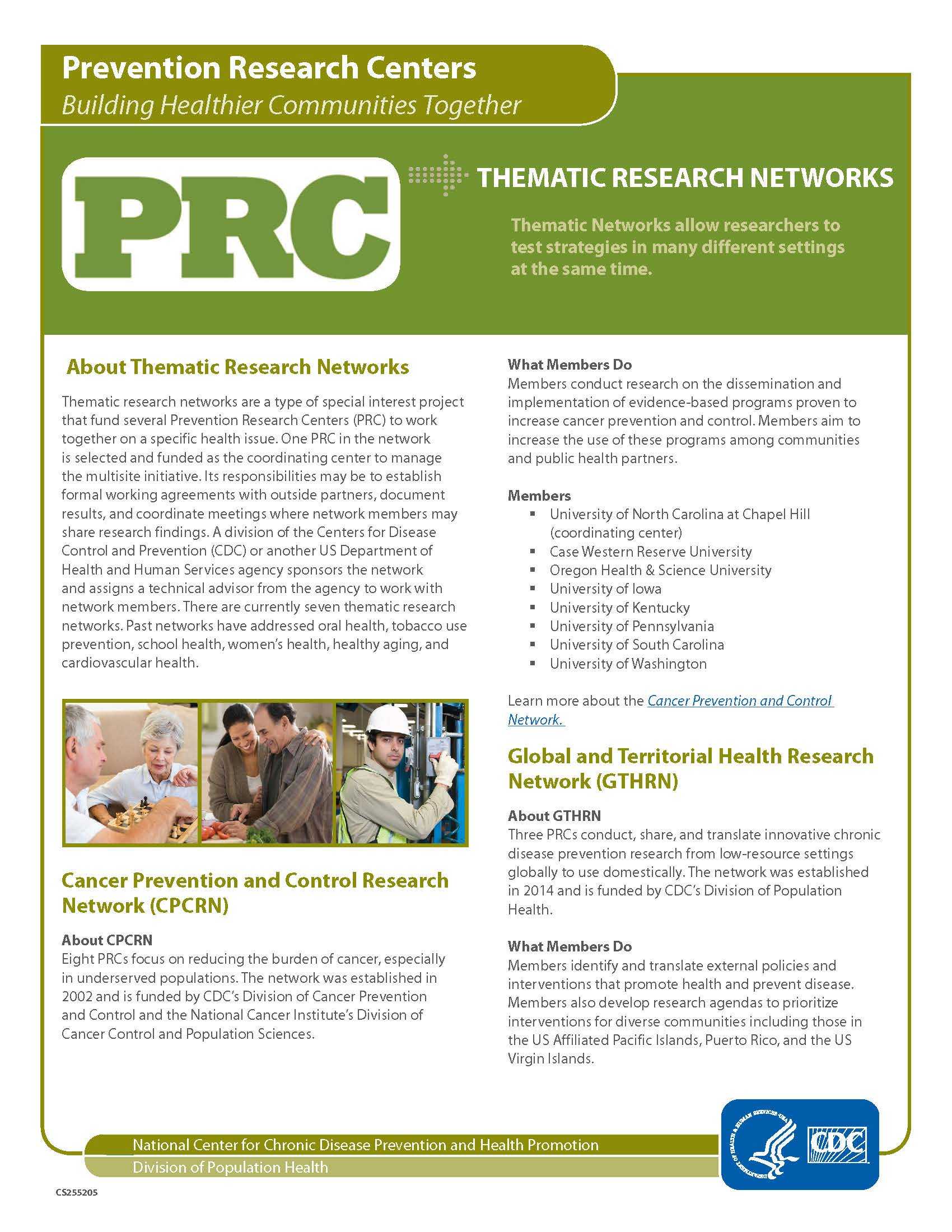Thematic Networks
Thematic research networks are a type of special interest project that fund several Prevention Research Centers (PRC) to work together on a specific health issue. One PRC in the network is selected and funded as the coordinating center to manage the multisite initiative. Its responsibilities may be to establish formal working agreements with outside partners, document results, and coordinate meetings where network members may share research findings. CDC or another US Department of Health and Human Services (HHS) agency sponsors the network and assigns a technical advisor from the agency to work with network members. There are currently seven thematic research networks. Past networks have addressed oral health, tobacco use prevention, school health, women’s health, healthy aging, and cardiovascular health.
Cancer Prevention and Control Research Network (CPCRN)
The CPCRN includes eight PRCs focused on reducing the burden of cancer, especially in underserved populations. Network members conduct research to help increase the use of proven programs for cancer prevention and control. Read about the CPCRN.
Global and Territorial Health Research Network (GTHRN)
The GTHRN includes three PRCs that collaboratively conduct, share, and translate innovative chronic disease prevention research in low-resource settings, particularly those relevant to the US-affiliated Pacific Islands, Puerto Rico, and the US Virgin Islands. The ultimate aim is to put such research into practice domestically and around the world. Read about the GTHRN
Healthy Brain Research Network (HBRN)
The Healthy Brain Research Network consists of six PRCs that build on the mission of CDC’s Healthy Brain Initiative to help address a growing public health challenge for our society — promoting cognitive health and addressing the growing number of older Americans living with cognitive impairment. Read about the HBRN.
Managing Epilepsy Well (MEW) Network
The MEW Network consists of eight PRCs that work to advance the science related to epilepsy self-management by conducting research with network and community stakeholders, implementing programs with partners, and broadly distributing research findings. Read about MEW.
The MEW booklet describes the structure and mission of the network and presents selected accomplishments. MEW Booklet, read more [PDF – 4.80MB]
Nutrition and Obesity Policy Research and Evaluation Network (NOPREN)
The NOPREN consists of five PRCs that study the effectiveness of policies focused on improving nutrition and preventing obesity through improved access to affordable, healthy foods in communities, workplaces, health care facilities, child care and education centers, and schools. Research focuses on population impacts and targeted approaches to improve health equity. Read about NOPREN.
Physical Activity Policy Research Network Plus (PAPRN+)
The PAPRN+ includes five PRCs that aim to advance policy research to increase physical activity of Americans. Network members will focus on policies that increase walking — the most popular form of aerobic physical activity in the United States. Read about PAPRN+.
Workplace Health Research Network (WHRN)
The WHRN consists of six PRCs focused on increasing the capacity of public health networks, employers, and their partners to implement science-based workplace health programs that can reduce health risks and improve the quality of life of working Americans, lower health care expenditures, and boost productivity. Read about WHRN
Related Materials
- Page last reviewed: July 31, 2017
- Page last updated: July 31, 2017
- Content source:


 ShareCompartir
ShareCompartir
